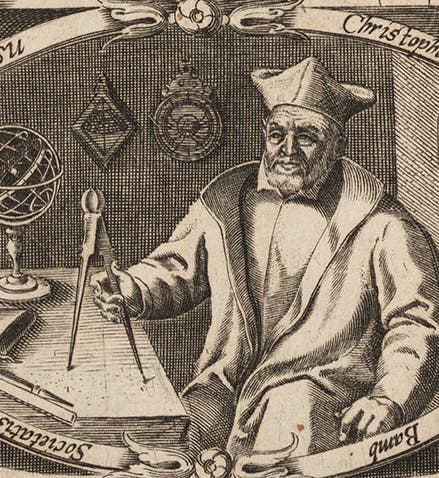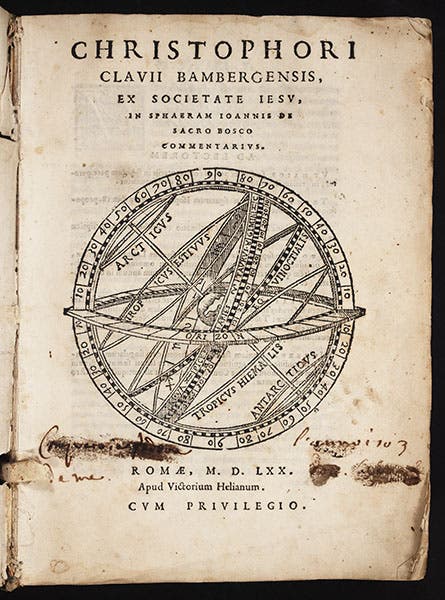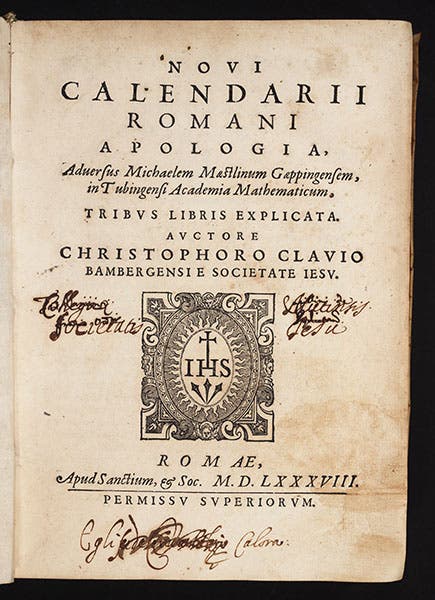Scientist of the Day - Christoph Clavius
Christoph Clavius, a Jesuit astronomer, was born Mar. 15, 1538. Clavius joined the Society of Jesus in 1555, when the Jesuit order was only 15 years old (and he was but 17). Clavius went on to teach at the Collegio Romano and played a major role in introducing astronomy and mathematics into the Jesuit curriculum; most of the great Jesuit astronomers of the 17th century – and there were many of them – owed their careers to Clavius's influence. Clavius believed in a traditional Aristotelian geocentric cosmology, as did nearly everyone at the end of the 16th century, in spite of Copernicus, and in 1570, he published the last important edition of Sacrobosco's Sphere, 92 years after the first edition was printed in Venice in 1478.
Clavius's Sphaera was a very popular text and was frequently revised and reprinted; we have five editions in our Library, printed between 1570 and 1607 (as well as the 1478 Venice edition that started it all). We show here three images from the 1570 edition: the title page, with an armillary as a vignette (second image); a geocentric cosmos (third image); and a diagram of the four elements and qualities (fourth image).
Clavius is often credited with playing a major role in the Gregorian calendar reform of 1582, which is not true - he had nothing to do with working out the details of the reform or implementing it. But when an expected text explaining the reform to the public did not appear, Clavius was tapped to write such a manifesto, so he took time off from compiling a new edition of Euclid's Elements to write Novi calendarii Romani apologia (Apology for the New Roman Calendar, 1588, fifth image). Since it was the first book to come out of Rome defending the Gregorian Calendar, one can understand why many assumed that Clavius played some role in shaping the reform, but he did not. Meanwhile, Clavius published his 2-volume Euclid the next year, 1589. He was a busy scholar.
In 1611, Galileo made a special trip to Rome to personally demonstrate a telescope to Clavius. Clavius was 73 years old, but he was impressed with what the telescope revealed, even if those revelations were at odds with Aristotle's teachings. But he had little time to contemplate the implications, as he died the very next year. That same year, 1612, his Opera was published, 5 large folio volumes that we have here in our Library. Ours is a beautiful set, in blind-stamped-and-rolled pigskin with brass clasps, that we bought from bookseller Jonathan Hill in 1986. The engraved title page (sixth image, left) shows the difference between Clavius's world and that of Galileo. We see the personifications of Geometry and Astronomy at the flanks, reflecting the standard view that astronomy is a mathematical art, but making no statement about what math can tell us about the world. Galileo, on the title page of Il Saggiatore (The Assayer, 1623, seventh image, on right), also featured two flanking figures, but they are Mathematics and Natural Philosophy, reflecting Galileo’s insistence that, if one wants to read the Book of Nature, one must understand the language in which it is written, which is mathematics.
If the name Clavius sounds familiar for some other reason, you may have a vestigial memory of an early scene in the film 2001: A Space Odyssey (1968), where there is a visit to a lunar station called Clavius Base, which sits inside Clavius crater. The crater Clavius was named in 1651 by Giambattista Riccioli, another Jesuit astronomer who was the beneficiary of Clavius’s pioneering work. We reproduced a view of Clavius crater, from a book by Johann Schmidt, Der Mond (1856), in our exhibition, The Face of the Moon; it is the crater at the top.
Dr. William B. Ashworth, Jr., Consultant for the History of Science, Linda Hall Library and Associate Professor, Department of History, University of Missouri-Kansas City. Comments or corrections are welcome; please direct to ashworthw@umkc.edu.










